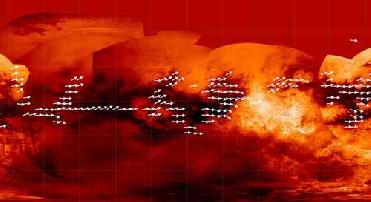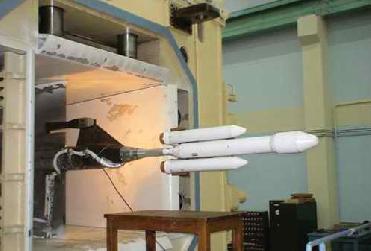
Scientists have used data from the Cassini radar mapper to map the global wind pattern on Saturn's moon Titan using data collected over a four-year period, as depicted in this image. Image credit: NASA/JPL/Space Science Institute
WASHINGTON (BNS): Scientists have discovered that Titan’s rippled dunes are generally oriented east-west. Their orientation and characteristics indicate that near the surface Titan’s winds blow towards the east instead of towards the west. Scientists said that this was an indication that Titan’s surface winds blow opposite the direction suggested by previous global circulation models of Titan.
Ralph Lorenz, Cassini radar scientist at Johns Hopkins University Applied Physics Laboratory in Laurel, Midland said that at Titan there are very few clouds and determining which way the wind blows was not an easy thing. But by tracking the direction in which Titan’s sand dunes form, there was an insight into the global wind pattern, Lorenz said.
The February 11 issue of Geophysical Research Letters carried the research findings.
Jani Radebaugh, Brigham Young University, Provo, Utah, said that Titan's dunes are young, dynamic features that interact with topographic obstacles and give clues about the wind regimes. “Winds come at these dunes from at least a couple of different directions, but then combine to create the overall dune orientation,” Radebaugh said.
NASA said that the wind pattern was important for planning future Titan explorations that might involve balloon-borne experiments. Some 16,000 dune segments were mapped out from about 20 radar images, digitised and combined to produce the new map, NASA said.
The Jet Propulsion Laboratory official said that Titan’s dunes are believed to be made up of hydrocarbon sand grains likely derived from organic chemicals in Titan's smoggy skies. The dunes wrap around high terrain, which provides some idea of their height.
They accumulate near the equator, and may pile up there because drier conditions allow for easy transport of the particles by the wind. Titan’s higher latitudes contain lakes and may be ‘wetter’ with more liquid hydrocarbons, not ideal conditions for creating dunes, the official said.
Cassini, which was launched in 1997, will visit Titan again on March 27. According to NASA, 17 Titan flybys are planned for this year.
 Next Article
Next Article













The Indian Air Force, in its flight trials evaluation report submitted before the Defence Ministry l..
view articleAn insight into the Medium Multi-Role Combat Aircraft competition...
view articleSky enthusiasts can now spot the International Space Station (ISS) commanded by Indian-American astr..
view article